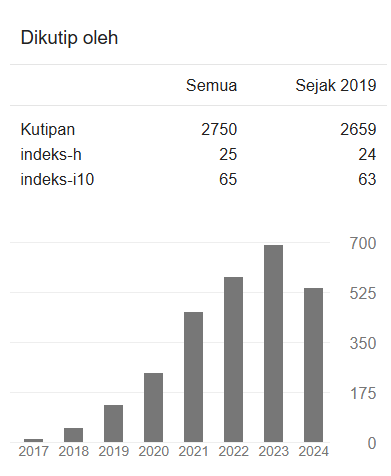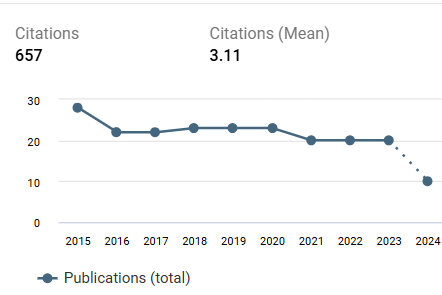Pengembangan aplikasi “SIMBA” (Social studies instructional media based android) untuk mata pelajaran IPS kelas VII SMP
DOI:
https://doi.org/10.22219/jinop.v7i2.15918Keywords:
Application, Learning Media, Social Studies LearningAbstract
Media is an important component in multidisciplinary social studies learning that must be presented in an integrated method. This study aimed to design learning media "SIMBA" (Social Studies Instructional Media Based on Android) and to analyze the feasibility based on an assessment by experts and students. The stages in this research and development were carried out by adopting 4D development, namely: define, design, develop, and disseminate. Due to limitations, the research was only carried out at the development stage, The research data is a feasibility assessment using a Likert scale from expert and VII grade students at SMP Negeri 21 Malang were collected using a questionnaire. The data were then analyzed by using the percentage descriptive technique. The results of the development were learning media which contains six menu components, namely: the competency and objectives, learning materials, our surroundings, videos, quizzes, and the developer menu. The results of the assessment from experts are “Very Appropriate”. While the students showed similar things which means the learning media "SIMBA" was feasible and could meet the needs of students in the learning process. Based on the weaknesses of this study, it is necessary to develop similar applications in other subjects that are capable of producing offline applications and can be accessed by teachers and students in the future.
Downloads
References
Abelson, H., & Harunani, F. 2012. Mit Apps Inventor: About Us. Massachusetts: Massachusetts Institute of Technology, dikases 7 Oktober 2019 on-line https://appinventor.mit.edu/about-us.
Abidin, Z. 2017. Penerapan Pemilihan Media Pembelajaran. Edcomtech Jurnal Kajian Teknologi Pendidikan, (Online), 1 (1): 9-20, (http://journal2.um.ac.id/index.php/edcomtech/article/view/1784), diakses 5 April 2021.
Afriani, A. 2018. Pembelajaran Kontekstual (Cotextual Teaching and Learning) dan Pemahaman Konsep Siswa. Jurnal Al-Muta`aliyah : Jurnal Pendidikan Guru Madrasah Ibtidaiyah, (Online), 1 (3): 80-88, (http://ejournal.kopertais4.or.id/sasambo/index.php/mutaaliyah), diakses 5 April 2021.
Akbar, S. 2017. Instrumen perangkat pembelajaran. Remaja Rosdakarya.
Alhassan, R. 2016. Mobile Learning as a Method of Ubiquitous Learning: Students’ Attitudes, Readiness, and Possible Barriers to Implementation in Higher Education. Journal of Education and Learning, (Online), 5(1): 176-189, (https://doi.org/10.5539/jel.v5n1p176), diakses 8 Maret 2021.
Anwariningsih, S. H., & Ernawati, S. 2013. Development of Interactive Media for ICT Learning at Elementary School Based on Student Self Learning. Journal of Education and Learning (EduLearn), (Online), 7(2): 121-128, (https://doi.org/10.11591/edulearn.v7i2.226), diakses 8 Maret 2021.
Apsari, F. Y., Rama, M. D., & Prasetyo, E. 2018. Konseling Berbasis Teks Menggunakan Riliv-Aplikasi Android. EXPERIENTIA : Jurnal Psikologi Indonesia, 6(1): 45–50, (https://doi.org/10.33508/EXP.V6I1.1790), diakses 8 Maret 2021.
Drigas, A. S., & Angelidakis, P. 2017. Mobile Applications within Education An Overview of Application Paradigms in Specific Categories. International Journal of Interactive Mobile Technologies (IJIM), (Online), 11(4): 17–29. (https://doi.org/10.3991/ijim.v11i4.6589), diakses 8 Maret 2021.
Elfmi, A. F., & Nayono, S. E. 2017. Pengembangan Mobile Encyclopedia Berbasis Android Sebagai Media Pembelajaran Mandiri. E-Journal Pend. Teknik Sipil Dan Perencanaan, (Online), 5(8): 1–7, (http://journal.student.uny.ac.id/ojs/index.php/sipil/article/view/8540), diakses 6 April 2021.
Endayani, H. 2018. Sejarah dan Konsep Pendidikan IPS. ITTIHAD: Jurnal Pendidikan, (Online), 2(2): 117–127, (http://ejournal-ittihad.alittihadiyahsumut.or.id/index.php/ittihad/article/view/43/36), diakses 5 April 2021.
Hakky, M. K., Wirasasmita, R. H., & Uska, M. Z. 2018. Pengembangan Media Pembelajaran Berbasis Android untuk Siswa Kelas X Pada Mata Pelajaran Sistem Operasi. Edumatic : Jurnal Pendidikan Informatika, (Online), 2(1): 24–33. (http://e-journal.hamzanwadi.ac.id/index.php/edumatic/article/view/ 868), diakses 6 April 2021.
Hanafi, Y., Murtadho, N., Alifudin Ikhsan, M., & Diyana, T. N. 2020. Reinforcing Public University Student’s Worship Education by Developing and Implementing Mobile-Learning Management System in the ADDIE Instructional Design Model. International Journal of Interactive Mobile Technologies (IJIM), (Online), 14(2): 215–241, (https://doi.org/10.3991/ijim.v14i02.11380), diakses 6 April 2021.
Idzhar, A., Negeri, S., & Abstrak, B. 2016. Peranan Guru Dalam Meningkatkan Motivasi Belajar Siswa. Jurnal Office, (Online), 2(2): 221-228 (https://doi.org/10.26858/JO.V2I2.2956), diakses 5 April 2021
Jiwanti, H. 2017. Pengembangan Media Pembelajaran Dasar Rias Berbasis Aplikasi Andriod Menggunakan App Inventor. Skripsi tidak diterbitkan. Semarang: Universitas Negeri Semarang.
Lestari, S. 2018. Peran Teknologi dalam Pendidikan di Era Globalisasi. EDURELIGIA: Jurnal Pendidikan Agama Islam, (Online), 2(2): 94–100, (https://doi.org/10.33650/edureligia.v2i2.459), diakses 5 April 2021.
Maimunah, M. 2019. Peran Media Gambar dalam Meningkatkan Pemahaman Siswa Tentang Konsep Hak Anak. Jurnal Visi Ilmu Pendidikan, (Online), 11(1): 53-61, (https://doi.org/10.26418/jvip.v11i1.30042), diakses 5 April 2021.
MCML. 2016. What is App Inventor?. Massachusetts: Massachusetts Institute of Technology, dikases 21 Oktober 2019 on-line https://appinventor.mit.edu/about-us.
Nurrita, T. 2018. Pengembangan Media Pembelajaran Untuk Meningkatkan Hasil Belajar Siswa. MISYKAT: Jurnal Ilmu-Ilmu Al-Quran, Hadist, Syari’ah Dan Tarbiyah, (Online), 3(1): 171-187, (https://doi.org/10.33511/misykat.v3n1. 171), diakses 5 April 2021.
Oktiana, G. D. 2015. Pengembangan Media Pembelajaran Berbasis Android dalam Bentuk Buku Saku Digital Untuk Mata Pelajaran Akuntansi Kompetensi Dasar Membuat Ikhtisar Siklus Akuntansi Perusahaan Jasa di Kelas XI MAN 1 Yogyakarta Tahun Ajaran 2014/2015. Skripsi tidak diterbitkan. Yogyakarta: Universitas Negeri Yogyakarta.
Oyelere, S. S., Suhonen, J., & Sutinen, E. 2016. Paper M-Learning: A New Paradigm Of Learning Ict In Nigeria M-Learning: A New Paradigm of Learning ICT in Nigeria. International Journal of Interactive Mobile Technologies (IJIM), (Online), 10(1): 35–44, (https://doi.org/10.3991/ijim. v10i1.4872), diakses 8 Maret 2021.
Ridha, M. 2021. Efektifitas Penggunaan Media Video pada Pembelajaran Tematik Terpadu di Sekolah Dasar Saat Pandemi Covid-19. Jurnal Pendidikan Tambusai, (Online), 5(1): 154-162, (https://doi.org/10.31004/JPTAM.V5I1. 925), diakses 5 April 2021.
Rusdi, M. 2018. Penelitian Desain dan Pengembangan Peendidikan : Konsep, Prosedur dan Sitesis Pengetahuan Baru. PT Raja Grafindo Persada.
Salsabila, U. H., Habiba, I. S., Amanah, I. L., Istiqomah, N. A., & Difany, S. 2020. Pemanfaatan Aplikasi Quizizz Sebagai Media Pembelajaran Ditengah Pandemi Pada Siswa SMA. Jurnal Ilmiah Ilmu Terapan Universitas Jambi, (Online), 4(2): 163–173, (https://doi.org/10.22437/jiituj.v4i2.11605), diakses 5 April 2021.
Sugiyono. (2016). Metode Penelitian Pendidikan Pendekatan Kuantitatif, Kualitatif, dan R&D. Alfabeta.
Tafonao, T. (2018). Peranan Media Pembelajaran Dalam Meningkatkan Minat Belajar Mahasiswa. Jurnal Komunikasi Pendidikan, (Online), 2(2): 103-114, (https://doi.org/10.32585/jkp.v2i2.113), diakses 6 April 2021.
Thiagarajan, S., Semmel, D., & Semmel, M. (1976). Instructional development for training teachers of exceptional children: A sourcebook. Journal of School Psychology, (Online), 14(1): 75-195, (https://doi.org/10.1016/0022-4405(76)90066-2), diakses 5 April 2021.
Undang-Undang Sistem Pendidikan Nasional (UURI No. 20 Tahun 2003. 2003. Jakarta: Kementerian Pendidikan dan Kebudayaan RI.
Undang-Undang Dasar 1945. 2002. Jakarta: DPR RI.
Wahyuningtyas, N. 2019. Developing edmodo-based online learning media to support student’s skill of social studies in 21th century. IOP Conference Series: Earth and Environmental Science, (Online), 243(1): 1-9, (https://doi.org/10.1088/1755-1315/243/1/012160), diakses 8 Maret 2021.
Wahyuningtyas, Neni, & Rosita, F. A. D. 2019. Pengembangan Multimedia Interaktif Berbasis Android Pada Materi Kehidupan Sosial Masyarakat Indonesia. Sejarah Dan Budaya Jurnal Sejarah Budaya Dan Pengajarannya, (Online), 13(1):34–41, (https://doi.org/10.17977/um020v13i12019p034), diakses 6 April 2021.
Zhao, F. 2019. Using Quizizz to Integrate Fun Multiplayer Activity in the Accounting Classroom. International Journal of Higher Education, (Online), 8(1): 31-43, (https://doi.org/10.5430/ijhe.v8n1p37), diakses 5 April 2021.
Downloads
Published
How to Cite
Issue
Section
License
Copyright (c) 2021 Wahyuningtyas et al

This work is licensed under a Creative Commons Attribution 4.0 International License.
Copyright Notice
Authors who publish with JINoP (Jurnal Inoasi Pembelajaran) agree to the following terms:
- For all articles published in the JINoP (Jurnal Inovasi Pembelajaran), copyright is retained by the authors. Authors give permission to the publisher to announce the work with conditions. When the manuscript is accepted for publication, the authors agree to the automatic transfer of the publishing right to the publisher.
- Authors retain copyright and grant the journal the right of first publication with the work simultaneously licensed under a Creative Commons Attribution 4.0 International License. that allows others to share the work with an acknowledgment of the work's authorship and initial publication in this journal.
- Authors are able to enter into separate, additional contractual arrangements for the non-exclusive distribution of the journal's published version of the work (e.g., post it to an institutional repository or publish it in a book), with an acknowledgment of its initial publication in this journal.
- Authors are permitted and encouraged to post their work online (e.g., in institutional repositories or on their website) prior to and during the submission process, as it can lead to productive exchanges, as well as earlier and greater citation of published work (See The Effect of Open Access).








